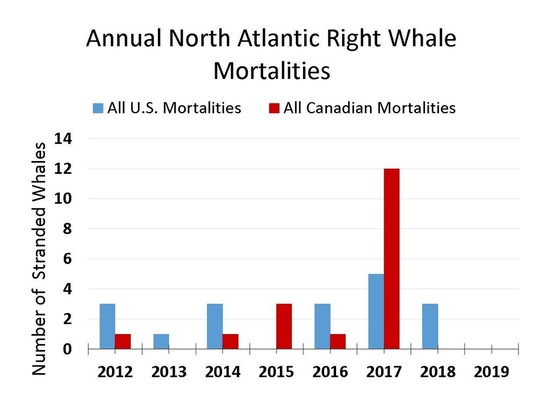What happened in 2017 and why is it significant?
North Atlantic Right Whales (NARW), along with many other baleen whales, were brought to the point of near extinction by commercial whaling. Whale bones were routinely used in clothing and other commodities. The real money, however, was in whale oil which was mostly used for oil lamps. In North America, this multi-million-dollar industry peaked from the mid 1800s to the early 1900s. Eventually, other fossil fuels became more popular and the whaling industry became less profitable. Commercial whaling was subsequently banned.
Unfortunately, whale populations have never come close to recovering from this traumatic event. Some whale populations, like NARW, suffered more than others. For example, NARW got their name because they were considered the ‘right whale’ to hunt due to their tendency to swim closer to the surface and inhabit coastal areas. Conservation efforts resulted in a consistent 2% increase in the NARW population per year for the last 25 years. The summer of 2017 marked a shock to this trend. While the mortality rate of NARW had remained at 3 deaths/year or lower for a number of years, 17 NARW died in 2017. This sharp increase in mortality severely compromised the strides that conservation efforts have made.

What did we learn about the causes of North Atlantic Right Whale Mortality?
Research into the 2017 crisis and NARW mortality in general has resulted in information on the determinants of mortality. While specific numbers vary, research indicates that the majority of NARW deaths are caused by humans. There are two main causes:
1) Vessel Strikes
NARW are most prone to ship strikes. The Gulf of St. Lawrence is a particularly busy shipping corridor with multiple international and national ports. As a result, thousands of vessels pass through the body of water each year, putting the NARW population at particular risk. A mandatory speed limit for ships passing through the Gulf of St. Lawrence since the summer of 2017 helped reduce the mortality rate in 2018.
2) Entanglement in Fishing Gear
New research into NARW mortality has noticed that more deaths are caused by entanglement in fishing gear than has been reported in previous years. 83% of the NARW population has experienced entanglements in fishing gear at least once in their lifetime.Why is this such a large number?Ocean warming and overfishing has forced fishing vessels to fish in deeper water. This forces them to use stronger ropes while also encroaching on NARW habitat.
Impacts of Trauma from Vessel Strikes and Entanglement on NARW Reproduction
A key factor of conserving NARWs is improving and promoting reproduction. New research indicates that trauma caused by human activities compromises reproduction as well. Preserving the lives of adult female NARW is the most effective way to promote population growth and recovery. If NARW survive fishing gear entanglement and vessel strikes, these events result in a major energy expenditure for the animal. For females, this means a decreased likelihood of reproduction and more years between births if they can reproduce. This is because the recovery period after the trauma is multiple months.
Want to learn more? Resources used:
https://www.sciencedaily.com/releases/2018/11/181107103605.htm
https://royalsocietypublishing.org/doi/full/10.1098/rsos.180892#d3e1679
